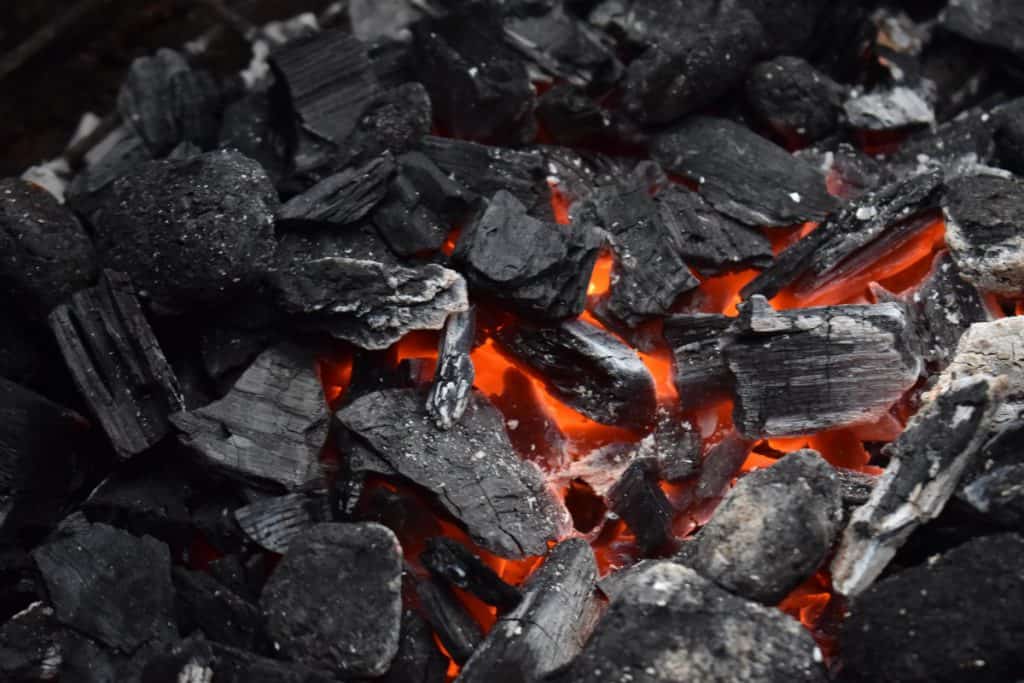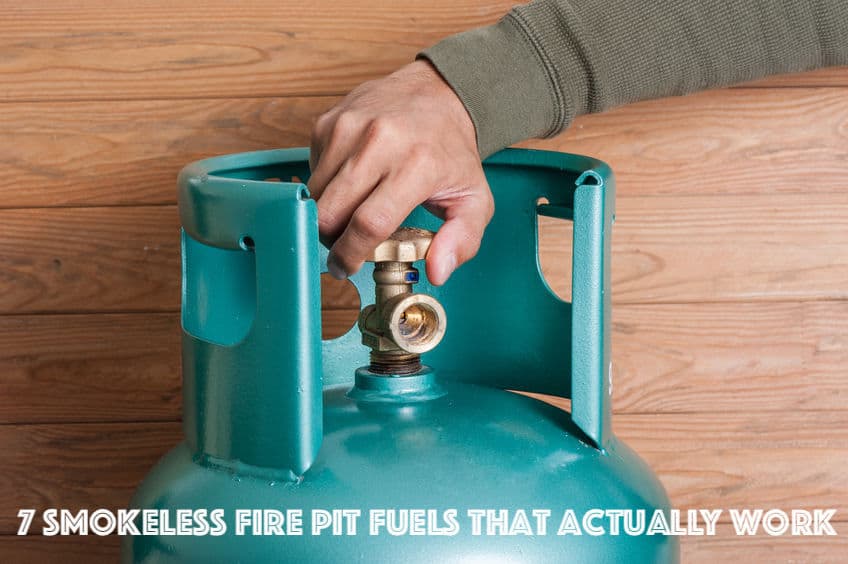Is there anything better than a roaring fire?
Whether you’re cooking dinner, roasting marshmallows with the kids, or looking to heat up a romantic night under the stars… nothing ruins a good fire like smoke!
The fire’s not even going yet and already you’re coughing, your eyes are burning… it’s the worst!
No worries, friends. These seven simple solutions will get your fire going without an excess of smoke.
7 Smokeless Fire Pit Fuels
Did you know that a damp log can contain more than 50% moisture?
When you put damp wood on a fire, it has to burn through all of that water to make use of the fuel. Not only does this create great clouds of noxious smoke — it also wastes energy and results in a less efficient burn.
“Smokeless fire pit fuels are more fuel efficient, which can save you money. Some options are also more environmentally friendly.“
You want to get that fire started and get on with your evening. Once you have a good blaze going, you want to be able to enjoy it without constantly dodging pillars of irritating smoke. Any of the following options will help you to have a lovely evening around the fire pit.

Seasoned Wood
We’ll start with a time-honored classic. Seasoned wood is what our forefathers used. It’s simply cut wood that’s been left to dry.
The wood is cut and stacked in a dry area so that the moisture contained in the wood can evaporate. The stack must be protected from the weather and have plenty of air flow.
If you don’t want to chop and season the wood yourself (what would your great-grandpappy think?!), this option is also one of the easiest to find in stores.
There’s a wide variety of seasoned wood. The smokiness depends on the type of wood, how it was seasoned, and the conditions in which it’s been stored.
The denser the wood, the less it will smoke. This is because denser woods have less room for moisture, and soft woods retain more sap. Very hard woods burn more like coal.
Hard Woods to Buy for Smokeless Fires:
– Black Locust
– Hickory
– White Oak
– Beech
– Ash
– Mulberry
– Black Walnut
Soft Woods to Avoid:
– Birch
– Sycamore
– Elm
– Aspen
– Pine
There are also special stoves you can buy that are designed to burn wood with minimal smoke.
The Solo Stove Ranger Outdoor Fire Pit offers more flame with less smoke with its carefully engineered design. A more efficient burn means a wonderful, real wood fire without those pesky plumes of smoke. This fire pit is made with heavy stainless steel to make sure it lasts for years of outdoor use.
The Solo Stove Ranger Outdoor Fire Pit is portable. The company also offers larger versions of the same design for a roaring bonfire.
If you’re willing to spend a bit more money on options that are guaranteed to be smoke free, keep reading!
Kiln-Dried Logs
This wood is — you guessed it — dried in a kiln. With an even lower moisture content than seasoned logs, kiln-dried logs are ideal for a smokeless fire.
Kiln-dried logs burn extraordinarily clean for quite a long time. Since no energy is wasted with evaporating trapped moisture, this wood burns hotter than other types of logs.
“Commonly made from oak, the best kiln-dried logs are certified USDA pest free with no chemicals! This high-quality wood is an excellent choice for cooking fires. They have a clean, pleasant smell.“
The only downside to this option is its price. Kiln-dried logs can be significantly more expensive than other options.
Use kiln-dried logs in a smokeless fire pit for a truly wonderful experience!

Smokeless Coal
There are types of coal designed to produce no smoke. They are manufactured from a different type of base carbon (usually anthracite) than standard coals. Naturally-occuring anthracite is ground to a powder and then reformed using a smokeless binding agent like molasses or starch.
These hard, shiny coals can be difficult to find in the United States; they’re more common in the United Kingdom.
Smokeless coal burns hot, lasts longer than many other fuel sources, and leaves very little ash behind. They generate about 80% less smoke than traditional coals. They’re more expensive up front, but burn so much hotter and longer that they can save you money in the long run.
Smokeless coals were created to combat air pollution, but modern studies have found that smokeless coals still contribute significantly to indoor air pollution. It would be best to use these outside, or try one of the cleaner options below.

Propane
Some fire pits are designed to burn propane!
Propane is liquified petroleum gas. It’s an excellent choice because it is both inexpensive and efficient. Propane is also widely available, easy to find, and easy to store (no need to worry about it getting damp).
Propane fires are a wonderful choice for cold winter nights. Damp weather or not, they’re easy to start. And many models put off significantly more heat than wood-burning fire pits.
There are a variety of stylish options available, like this Sunnydaze Square Outdoor Propane Gas Fire Pit Table with Weathered Wood Look. This sturdy, clean-burning option is a wonderful choice for small spaces. There are also beautiful rectagular styles available through Amazon from the same brand.
“If you live in a drought-prone area with frequent campfire bans, a pre-approved fire pit can be your ticket to a merry campfire!“
There is an amazing array of options for propane gas fire pits:
This Outland Firebowl Portable Propane Gas Fire Pit allows you to create a safe and easy fire pit wherever you’d like. It’s CSA approved and safe to use during most campfire bans. It’s an excellent choice for RV campers, as it gives you easy access to a fire at campsites that don’t allow their guests to burn wood.
The Best Choice Products 30,000 BTU Gas Fire Pit is shaped like a traditional circular fire pit. It puts off plenty of heat and comes with lava rocks for the center. This simple model is particularly easy to set up.
Finally, the BALI OUTDOORS Gas Fire Pit Table is an eye-catching piece filled with bright blue fire glass (which can be switched out for another color of your choice). This model is quite large, but quick and easy to install. A lid makes this piece particularly versatile; you can convert the fire pit to a table when it’s not in use.
Rubbing Alcohol
You may have encountered lightweight camp stoves that burn rubbing alcohol, but did you know that there are also a wide range of beautiful fire pits designed to burn rubbing alcohol as well?
This is a wonderful option if you’re looking to add ambiance to small spaces. They can be used either outside or indoors.
Most of these options are quite small and designed for tabletop use. You can find one to match your decor. This White Table Top Fire Bowl from Terra Flame is just gorgeous.
Bioethanol
Other beautiful conversation pieces, like this Teal Blue Table Top Fire Bowl, burn bioethanol.
Bioethanol is a type of biofuel made by fermenting biomass materials like corn. It does not release carbon into the atmosphere. Since it’s made from plants, this energy source is renewable!
Gel Fuel
Fuels such as Real Flame Gel Fuel are made with gelled isopropyl alcohol. This smokeless fuel is designed to be used in specific fire pits, which are meant to be kept indoors in well-ventilated areas.
Real Flame Gel Fuel lasts for up to three hours. The flames burn bright orange, just like a real fire. This clean-burning gel doesn’t give off any smoke or leave ash or soot behind.
Bonus! Avoid These Common Mistakes:
Stay safe with these simple tips.
Never burn smokeless fuel overnight.
Make sure your fire is completely extinguished before going to bed. Do not leave any fire unattended.
Never burn damp coal.
Even smokeless coals can’t burn clean if they’re wet. This particular fuel can leave a terrible residue behind if you try to burn it once it gets damp. Try burning damp smokeless coals, and you might end up with a gooey mess.
Never mix fuel sources.
Do not use one type of fuel to feed a fire pit designed for something else.
Never mix smokeless coals with wooden logs. Coals need air from below the grate to burn, while wood needs air from above. Burning both together is very inefficient, as one can smother the other. Also, any moisture from the wood can cause an unpleasant chemical reaction when it hits the coals
Conclusion
There are a wide variety of options available. Many fire pits are designed to burn a specific type of fuel, so consider carefully before investing in a fire pit. You’ll want to consider which fire pit is the best fit for your space as well as what functions you want it to serve.
Heat? Cooking? An eye-catching conversation piece?
It’s up to you!
Make sure that the fuel your fire pit requires is easily available to you before making a big purchase.
And finally, ENJOY!
Alright, that’s it for this article guys, if you found it useful then a share on social media or your website would be cool!
All the best
Steve
ps here’s a few articles related to this one you might find interesting:
37 Fire Pit Accessories That Just MAKE SENSE!
Do Fire Pits Create a Lot of Smoke? (Things to Know & Steps to Take)

